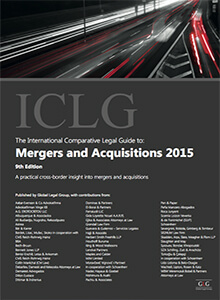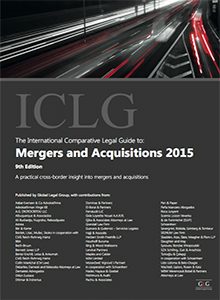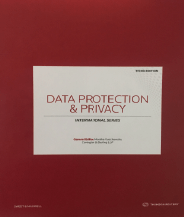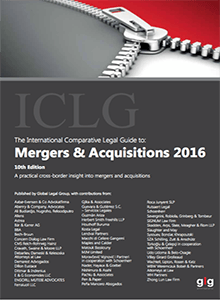Mergers and Acquisitions 2015

 By Gabriela Mancero
By Gabriela Mancero
GLOBAL LEGAL GROUP
1.1 What regulates M&A?
Mergers and acquisitions are regulated in different statutes including laws, decrees, resolutions and circular letters. M&A regulation is usually included in each of the main sectors of the economy in Colombia.
For instance, the Code of Commerce, as amended by Law 222 of 1995, regulates mergers and acquisitions in general. Law 1258 of 2008 includes specific rules for the merger of simplified stock corporations.
Articles 60 and 63 of the financial system organic statute regulate mergers and acquisitions in the financial sector. While M&A transactions between financial entities (including corporations listed in the Colombian stock exchange) are regulated and authorised by the Financial Superintendence, the Superintendence of Corporations is in charge of clearing transactions not caught under the supervision of other Superintendences and meeting certain thresholds.
Aerocivil regulates certain M&A transactions in the air transport industry, such as code-sharing agreements, joint operations, use of charter aircrafts and exchange and blocking of slots.
The Superintendence of Ports and Transports clears mergers and spin-off transactions regarding corporations doing business in that sector.
Decree 2555 of 2010 governs acquisitions deriving from public offers of shares.
Additionally, the following is the main legislation regulating merger control by the Colombian competition agency:
| Constitution (Arts. 333 and 334) | Economic freedom subject to intervention in cases of abuse of a dominant position, social interest, environment and Nation’s cultural heritage. |
| Law 155 of 1959 | M&A regulatory framework. |
| Law 1340 of 2009 | Competition statute. |
| Decree 1302 of 1964 | Regulation of Law 155 of 1959. |
| Decree 2153 of 1992 | Institutional framework for the competition agency. |
| SIC Circular 10 | M&A filing procedure and requirements. |
| Resolution 12193 of 2013 | Regulates filing procedure requirements and guidelines. |
The national competition agency in charge of merger control is the Superintendence of Industry and Commerce (SIC).
1.2 Are there different rules for different types of company?
Yes. A distinction may be made between publicly held corporations (including entities in the financial sector of the economy) and corporations that are not listed in the Stock Exchange or financial entities (as defined by the Colombian Financial System Organic Statute – FSOS).
As far as merger control is concerned, Law 1340 of 2009 granted SIC the sole competence for merger control in all sectors of the economy and all types of companies. Nevertheless, the following sectors are governed by their own rules:
- Mergers in the financial and insurance sectors are governed by the Organic Statute for the Financial System (Decree 663, 1993) and are enforced by the Financial Superintendence.
- Mergers between airlines are regulated mainly by article 1866 of the Code of Commerce and article 3.6.3.7.3 of the Colombian Aeronautic Regulation – RAC.
- Law 182 of 1995 governs mergers between television operators.
- Law 226 of 1995 governs the privatisation processes concerning State-owned corporations.
- Law 1 of 1991 and External Circular No. 1 of 19 January 2010 govern mergers of entities supervised by the Superintendence of Ports and Transport.
1.3 Are there special rules for foreign buyers?
Yes, foreign buyers have specific rules concerning ownership (either sectors where they may not participate such as national security or toxic wastes or maximum participation percentages such as financial institutions). In some cases they will also require to establish a local vehicle (for example, when carrying out permanent activities in the mining or oil and gas sectors).
From the merger control perspective, M&A transactions involving foreign parties are also subject to Colombian law provided the relevant thresholds are met. In this sense, no distinction is made.
1.4 Are there any special sector-related rules?
Even though Law 1340 of 2009 established one sole national competition agency, there are special sector-related rules for financial entities (including corporations listed in the Colombian Stock Exchange), airlines, companies in the ports and transport industry and television operators. In certain sectors, there are special rules setting limits to concentrations or vertical integration, such as energy and gas, health providers and financial institutions.
1.5 What are the principal sources of liability?
Liability may derive from any act or omission concerning compliance with the requirements of the corresponding M&A procedure. For example, mergers carried out with providing minority shareholders with the right to withdraw from the company in the circumstances established by law; M&A transactions implemented without prior authorisation or notification by the corporate or competition agency if they require such prior authorisation or notification; acquisitions that require a prior public offering (OPA from Spanish “oferta pública de acciones”) that are carried out without compliance with such OPA.
2 Mechanics of Acquisition
2.1 What alternative means of acquisition are there?
There is not an exhaustive list of transactions that are deemed an acquisition in Colombia. The following are the most common means of acquisition:
- mergers (either through the incorporation of a new entity or the absorption of an existing one);
- share purchases;
- asset purchases;
- privatisations;
- purchases of on-going concerns (commercial establishments);
- public offers (OPA); and
- incorporated or unincorporated joint ventures.
2.2 What advisers do the parties need?
This is not regulated in Colombian law. Parties are free to choose the advisers they deem convenient but, in general, procedures before government agencies and authorities require representation by attorneys licensed to act in Colombia.
For listed shares it is necessary to hire a local brokerage firm, since such firms are the only corporations authorised to trade listed shares.
2.3 How long does it take?
Timing varies broadly depending on the nature and sector of the parties involved. For instance, non-listed entities that wish to merge and fall within any of the conditions established by Decree 4350 of 2006 and Circular 001 of 2007 require prior authorisation by the Superintendence of Corporations. The authorisation procedure may take an average of 60 days but may vary depending on the entity’s workload. Share acquisitions do not require such approval but, in that case, timing will depend on the pre-emptive rights and prior internal authorisation procedures in place in the corresponding corporation’s by-laws.
Listed corporations or financial entities that wish to merge, require prior approval by the Financial Superintendence. The entity has two months to decide on whether to approve or object to the corresponding merger. If the merger agreement is executed by shareholders holding 95% or more of the stock, the Financial Superintendence will have only one month to decide.
OPAs require prior authorisation by the Financial Superintendence. The timing for acceptance of the offer must be determined in the corresponding public offer but it may not be either less than 10 business days or more than 30 business days, counted as from the date of receipt of the corresponding acceptance.
In all the above cases, i.e. M&A regarding listed and non-listed corporations, a merger filing (either for prior approval or for notification) will be required. Such procedure may take from one business day (in the case of notification) to an average of three months (if prior authorisation is required).
2.4 What are the main hurdles?
The main hurdle has to do with the time that government agencies usually take to make a decision concerning an M&A transaction. Given the fact that merger control is ex-ante in Colombia, many transactions must wait for clearance before being implemented. Something similar happens at corporate level both before the Superintendence of Corporations and the Financial Superintendence. Furthermore, in the case of mergers, there is a waiting period of 30 business days during which creditors may request further guarantees to secure their credit.
2.5 How much flexibility is there over deal terms and price?
As a general rule, deal terms and price can be freely agreed upon by the parties involved. There are however certain restrictions regarding the sector or transaction type. The following are some of the main examples:
- pursuant to article 90 of the Tax Statute, sale price for shares may not be lower than 75% of their intrinsic value (which in non-listed corporations is deemed to be its commercial value);
- in certain energy-related sectors, some agents may not acquire over 25% of the market share;
- in the case of shareholders who are State-owned, such shares may not be acquired by third parties until and unless a pre-emptive right is granted to the social economy sector (including organisations such as cooperatives, non-profit organisations and charities) – Article 60 Constitution and Law 226 of 1995;
- in non-listed corporations, it is possible to agree on restrictions to the free negotiation of shares, such as the exercise of pre-emptive rights in favour of the company or in favour of the other shareholders (Article 379(3) and 407 Code of Commerce); and
- financial entities may not acquire over 10% of the stock of another financial entity (Article 10 Financial System Organic Statute).
2.6 What differences are there between offering cash and other consideration?
Price is one of the essential elements in an acquisition. Form of payment however is not. Therefore the general rule is that parties may offer cash or any other consideration. Exchange regulation establishes different modalities for payment of consideration including cash payment and in-kind payment, which in turn may be through tangible or intangible property.
2.7 Do the same terms have to be offered to all shareholders?
No. However, shareholders within the same share series may not be offered different terms among them.
2.8 Are there obligations to purchase other classes of target securities?
The purchase of shares is not conditioned to the purchase of other classes of target securities.
2.9 Are there any limits on agreeing terms with employees?
There are no limits. However, the Colombian Labour Statute establishes strict rules regarding employee substitution and/or transfer. Basically such rules tend to protect the employees’ seniority and to provide for joint liability between the seller and buyer regarding labour-related obligations existing or deriving from the period prior to the acquisition.
2.10 What role do employees, pension trustees and other stakeholders play?
Employees, pension trustees and other stakeholders who are creditors of the target, have the right to ask for a reinforced guarantee if they believe that the transaction will affect their credit in any way. Minority shareholders, who were absent or did not agree with the merger transaction, may withdraw from the corporation if a decrease in their equity is suffered regarding their shares as a consequence of the majority shareholders’ decision to approve the merger.
2.11 What documentation is needed?
Documents vary depending on whether it is a merger or an acquisition, on the target’s sector, whether it is a publicly held corporation, if the acquisition is completed through a public or private offer, or on whether merger control thresholds are met.
Mergers
The documents required for any merger are:
- the minutes of the companies’ board of shareholders meetings whereby the merger agreement is approved;
- the merger agreement including an explanation of the merger justification; the financial statements of the companies involved before and after the merger is implemented; the distribution of shares among shareholders after the merger is implemented; the by-laws of the company that will survive the merger; a list of assets and liabilities of the entities involved;
- the press announcement and a letter to all creditors informing them about the merger; and
- the amendment to the by-laws approving the final terms of the merger.
Mergers involving entities in the following sectors will require additional documents mainly intended to evidence that the transaction will not affect the relevant market or users/customers:
- entities supervised by the Financial Superintendence;
- entities supervised by the Superintendence of Corporations not falling within the general authorisation regime;
- entities supervised by the Superintendence of Transport and Ports;
- entities supervised by the Health Superintendence; and
- entities supervised by the Civil Aviation Authority.
Acquisitions through private offer
The documents required are:
- the offer letter issued by seller(s);
- the minutes of the board of shareholders’ meeting evidencing exercise or waiver of pre-emptive rights (or acceptance letter if no pre-emptive rights procedure applies);
- the stock purchase agreement;
- the endorsed share certificates in favour of the buyer;
- the income tax returns filing (if the seller is a foreign investor); and
- the foreign investment cancellation application (if the seller is a foreign investor) or the foreign investment substitution application (if the buyer is also a foreign investor).
Acquisitions through public offer
Resolution 400/95 issued by the Financial Superintendence regulates the subscription, acquisition and transfer of securities in Colombia. The said resolution demands compliance with its requirements (registration of securities, registration of issuer, etc.) in those cases where a public offer of securities will take place in Colombia or when the issuer is a Colombian legal entity.
Under Colombian securities regulation a public securities offer is defined to be “any offer of securities made to ‘undetermined persons’ or to 100 or more determined persons for purposes of subscribing, transferring or acquiring securities”. That is, an offer of securities made to less than 100 persons that have been clearly specified does not constitute a public offering in Colombia and is not subject to the requirements under Colombian securities law.
The documents required include:
- information about the target and the Bidder (and its subsidiaries), including the disclosure of the number of Voting Shares owned (directly or indirectly) by each entity;
- the OPA’s terms and conditions, such as the number of securities, price, thresholds, acceptance period length and others; and
- any agreements entered into between the Bidder and any current shareholders of the target company (Prearranged Transactions), or the target company’s current management (including the benefits offered to the managers), the purpose of the acquisition and the Bidder’s business plan for the target’s future, and the guarantees that the Bidder will provide.
This information must be included in an offering booklet (cuadernillo de oferta) and in an offering notice draft (the Offering Notice), which shall be delivered for review and approval by the Financial Superintendence. The same information shall be delivered to the BVC for review of the guarantees and stock exchange proceedings.
The day after the filing, the Financial Superintendence will notify the BVC about the filing and will order the BVC to suspend the trading of any Voting Shares. Trading remains suspended until the day after the publication of the first Offering Notice.
M&A transactions meeting merger control thresholds
- Having less than 20% of the market share.
In this case the main document required is an economic study of the market share evidencing the threshold. The filing consists of a notification to the Superintendence of Industry and Commerce, which can be made online.
- Having more than 20% of the market share.
This is a more complex filing, which includes a newspaper announcement of the transaction and the opinion of the sector authority. The main documents required have to do with:
- the structure and operating status of the company;
- a description of the transaction and the possible time it may take to be completed;
- an identification of the relevant market, identifying relevant products or services and geographical markets;
- an identification of competitors, any competing products, the percentage of the market served, installed capacity, relations with the producers of raw materials and distributors, minimum initial investment to start a competing entity in the relevant market, technical requirements to start a competing entity; and
- the suppliers and distribution channels.
2.12 Are there any special disclosure requirements?
Any public offering of securities must comply with the disclosure requirements provided in Resolution 400/95 of the Financial Superintendence and must be authorised by the said Superintendence. The prospectus must contain all such information as investors and their professional advisors would reasonably require and reasonably expect to find in the prospectus for the purpose of making an informed investment decision.
If the party making the offer to acquire shares is making a tender offer in exchange for shares or other securities into another company, the securities must meet certain requirements and the offeror must comply with additional disclosure requirements, as provided under Resolution 400/95.
2.13 What are the key costs?
There are no government fees or official charges. Nevertheless, the following costs are typically involved in a transaction:
- the newspaper notice expense;
- the investment bank and attorneys’ fees;
- the brokerage fee; and
- in merger transactions, the corresponding Chamber of Commerce charges a registration tax of 0.7% of the merged entity’s subscribed capital.
2.14 What consents are needed?
OPAs and M&A transactions by entities supervised by the Financial Superintendence require consent from that entity. The other consents that are required are:
Entities supervised by the Superintendence of Corporations not falling within the general authorisation regime must obtain consent by that entity prior to any merger. A similar consent is required by the corresponding entity in the following cases:
- when entities are supervised by the Superintendence of Transport and Ports;
- when entities are supervised by the Health Superintendence; and
- when entities are supervised by the Civil Aviation Authority.
From the perspective of antitrust regulation, the Superintendence of Industry and Commerce’s authorisation is required prior to the implementation of the transaction if the corresponding merger control filings are met.
2.15 What levels of approval or acceptance are needed?
M&A transactions usually require simple majority consent from the board of shareholders of the corporations involved in the transaction. In some cases, it is possible that certain corporations require unanimity or a qualified majority approval.
In OPAs, acceptance of the offer may be exercised through any stockbroker belonging to the Colombian Stock Exchange within the Acceptance Period or any extension thereof. Acceptance must be presented through the Colombian Stock Exchange forms and must comply with the requirements of the Colombian Stock Exchange Regulation (articles 3.3.3.10 of the Regulation, articles 3.9.1.2 and 3.9.1.3 of the Stock Exchange Circular) and with its operating guidelines. The starting date of the acceptance receipt shall not be less than five business days counted as from the publication date of the first offer announcement.
2.16 When does cash consideration need to be committed and available?
There is no specific legal requirement regarding the availability of cash consideration. In any case, the Bidder must indicate the manner in which the price of the shares to be acquired will be paid. If loans or capital contributions are committed, the Bidder shall provide the necessary supporting information to conclude that there are available funds to pay the price.
3 Friendly or Hostile
3.1 Is there a choice?
Even though there is a choice in Colombia hostile takeovers are not common mainly because share ownership is concentrated in very few parties who control the target, acting individually or jointly (pursuant to shareholders’ agreements). Therefore, typically, only a minor percentage of the shareholding is actually owned by institutional investors or floats in the market. As a consequence, pre-arranged and friendly takeovers (acquisitions of control) are very common in Colombian listed companies.
3.2 Are there rules about an approach to the target?
There is no formal procedure or rule regarding an approach to the target. In practice, an agreement is reached with the controller of the company with the support of an investment bank.
3.3 How relevant is the target board?
The target board is in charge of issuing a decision regarding the convenience of an OPA for shareholders. The board will approve the share issuance regulation including the terms and conditions that will be finally approved by the Board of Shareholders.
3.4 Does the choice affect process?
Friendly OPAs involve a negotiation process and agreement, which creates a cooperative environment that facilitates the transaction. On the other hand, in a hostile process the Bidder will have less information than in a friendly OPA, and will have no further representation and warranties from the target.
4 Information
4.1 What information is available to a buyer?
In no publicly traded corporations will the buyer be able to obtain only publicly available information such as: a good standing certificate which includes the capital, corporate purpose, names and positions of administrators and term. If the corporation is supervised by a government agency such as the Superintendence of Corporations or the Financial Superintendence, there will also be certain financial information available to the public. Any additional information will be confidential and the seller will have to provide it as part of the transaction data room.
In publicly traded corporations, the information available to a buyer is much broader as it includes annual reports, complete financial statements and relevant information or changes to the target’s financial situation as reported to the Financial Superintendence.
4.2 Is negotiation confidential and is access restricted?
Negotiation is confidential. Nevertheless, in publicly traded companies, the previous agreement between the parties of the essential elements of a transaction over shares, bonds or mandatorily convertible bonds must be publicly disclosed to the Financial Superintendence and the stock exchange or trading system in which it will take place, at least one month in advance of the agreed trade date.
4.3 When is an announcement required and what will become public?
An announcement is required in all OPAs and in any merger transaction, which requires a newspaper announcement of the transaction.
A newspaper announcement of the transaction is also required for merger control purposes if the parties involved meet the filing threshold and their individual or joint market share exceeds 20%.
The main characteristics of the transaction will become public but the parties may request that confidential information is not published.
4.4 What if the information is wrong or changes?
If the information changes, it must be informed to the Financial Superintendence and to the Bidders. If it is wrong, the Financial Superintendence (or the Superintendence of Corporations if applicable) may impose fines and penalties and order that the target take any measure deemed necessary to make sure that all parties obtain accurate information and that the transaction is not affected. In privately held transactions, information that has changed or is wrong can lead the parties’ to a price adjustment or to the granting of collateral to cover any eventual liability deriving from that circumstance.
5 Stakebuilding
5.1 Can shares be bought outside the offer process?
No shares can be bought outside of the offer process if it is an OPA. If the offer is private, parties may negotiate shares outside the offer.
5.2 Can derivatives be bought outside the offer process?
Yes, though Colombia’ s derivatives market is mainly OTC.
5.3 What are the disclosure triggers for shares and derivatives stakebuilding before the offer and during the offer period?
Before the offer a filing for authorisation must be made before the Financial Superintendence, which must include: a wide range of information about the target; the Bidder (and its subsidiaries), including the disclosure of the number of Voting Shares owned (directly or indirectly) by each entity; the OPA’s terms and conditions, such as the number of securities, price, thresholds, acceptance period length and others; any agreements entered into between the Bidder and any current shareholders of the target company (Prearranged Transactions), or the target company’s current management (including the benefits offered to the managers); the purpose of the acquisition and the Bidder’s business plan for the target’s future; and the guarantees that the Bidder will provide.
This information must be included in an offering memorandum (cuadernillo de oferta) and in an offering notice draft (the Offering Notice), which shall be delivered for review and approval by the Financial Superintendence. The same information shall be delivered to the BVC for review of the guarantees and stock exchange proceedings.
Apart from the above, there is no further disclosure obligation before the offer or during the offer period.
5.4 What are the limitations and consequences?
Any offer of securities made to ‘undetermined persons’ or to 100 or more determined persons for purposes of subscribing, transferring or acquiring shares necessarily required to be made through an OPA and previously authorised by the Financial Superintendence. If made without complying with this requirement, the offering will be void.
6 Deal Protection
6.1 Are break fees available?
Break fees are available between the offeror and the initial Bidder in the OPA provided their general terms have been informed to the Financial Superintendence and it is assured that funds do not come from the target but directly from its shareholders.
- Can the target agree not to shop the company or its assets?
Yes, the target can agree not to shop the company or its assets.
- Can the target agree to issue shares or sell assets?
No, if an OPA has been launched, the target may not agree to sell assets. In privately held companies, the target can agree either to issue shares or sell assets, provided the relevant corporate body has approved such a sale.
- What commitments are available to tie up a deal?
Commitments to tie up a deal are reflected in the agreement to tender with the controller. This is a private agreement, which is binding only to the parties.
7 Bidder Protection
7.1 What deal conditions are permitted and is their invocation restricted?
Deal conditions are regulated entirely by the OPA booklet, the information memorandum and the underlying OPA regulation by the Financial Superintendence. Therefore, all terms will be governed by such regulation.
7.2 What control does the bidder have over the target during the process?
The Bidder can enforce the representations and warranties granted by the target.
7.3 When does control pass to the bidder?
The Bidder takes control of the target when registered in the target’s shareholders ledger and the controller’s board member nominees are appointed.
7.4 How can the bidder get 100% control?
A Bidder can get 100% control by conducting an OPA to the remaining shareholders or, if an OPA is not required, by negotiating individual share purchase agreements with the remaining minority shareholders.
8 Target Defences
8.1 Does the board of the target have to publicise discussions?
Discussions by the board of the target must be reflected in the minutes recorded in the target’s board book of minutes but they do not have to be publicised.
8.2 What can the target do to resist change of control?
There are no laws or regulations that specifically govern takeover defences in Colombia. However, OPA regulations include limitations and restrictions for the parties (including the target) during the course of an OPA.
In this sense, the target company, its managers and other shareholders interested in obtaining a controlling interest, or preventing a third party from obtaining it, may engage in any type of defensive strategy they deem convenient, provided that such strategy does not violate OPA rules and limitations.
8.3 Is it a fair fight?
OPAs regulations include provisions whereby a third party, who is also an interested investor, may “interfere” in an OPA. The third party may launch a simultaneous competing or concurrent OPA over the same target company.
The concurrent OPA may be launched after the initial OPA authorisation has been requested but before it has been granted.
If the third party requests authorisation for a competing OPA, that is after the initial OPA has been authorised, such a competing OPA may interfere with the initial OPA only if the first Offering Notice of the competing OPA is published at least two days before the Accepting Period of the initial OPA ends.
9 Other Useful Facts
9.1 What are the major influences on the success of an acquisition?
The major influences on the success of an acquisition are process transparency and accuracy and the Financial Superintendence’s timely approval.
9.2 What happens if it fails?
If the acquisition fails, the buyer will have to bear the expenses incurred in the OPA but no other consequences will derive.
10 Updates
10.1 Please provide a summary of any relevant new law or practices in M&A in Colombia.
On 25 October 2013, the OECD formally launched Colombia’s accession process to that organisation. The accession roadmap determines that Colombia will undergo in-depth reviews by a number of technical OECD committees, which will provide a formal opinion to the Council. One example of such committees is the competition committee, the goals of which are:
- ensuring the effective enforcement of competition laws through the establishment and operation of appropriate legal provisions, sanctions, procedures, policies and institutions;
- facilitating international co-operation in investigations and proceedings that involve the application of competition laws; and
- actively identifying, assessing and revising existing and proposed public policies whose objectives could be accomplished with less anti-competitive effect, and ensuring that persons or bodies with competition expertise are involved in the process of such competition assessment.
SIC is actively working towards the accomplishment of such goals. This can be evidenced in the number of recent regulations passed together with the increasing number of investigations and cases decided by the entity.
One example concerning M&A regulation is Resolution 12193 of 2013 passed by SIC to regulate in detail the merger control procedure. The new regulation, passed in March 2013, allows for the parties to request a prior hearing to solve queries concerning the filing, documents to be filed and, in general, to receive guidance on the clearance procedure, it also allows SIC to request information from third parties – competitors or consumers – at an early stage of the procedure, it clarifies that M&A transactions involving undertakings that are under one control unit are exempt from requesting clearance, among others.
*. GLOBAL LEGAL GROUP. Questions For The International Comparative Legal Guide To: Mergers and Acquisitions, 2015.

Cultural Heritage of the Nation in Colombia: Concept, Background, Jurisprudential Development

Data Protection & Privacy

